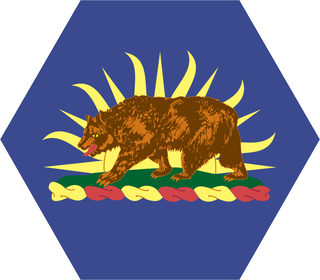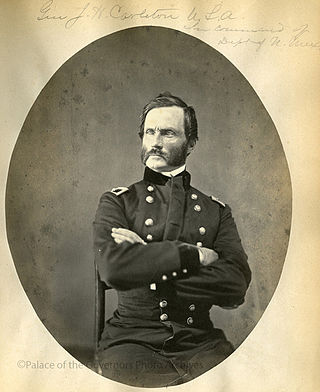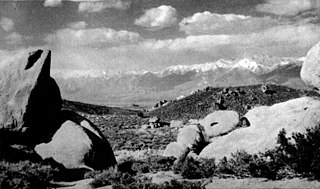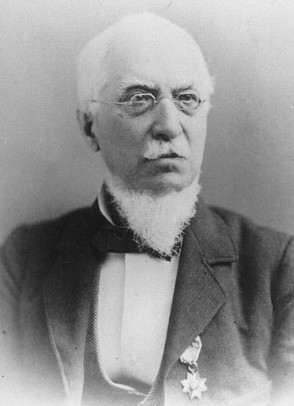
The District of Southern California was a 19th-century district of Department of the Pacific, a command of the United States Army.

The District of Southern California was a 19th-century district of Department of the Pacific, a command of the United States Army.
Department of the Pacific was created January 15, 1861, during the American Civil War. The District of Southern California was established on September 25, 1861.
The district was composed of San Luis Obispo County, Tulare County, Santa Barbara County, Los Angeles County, San Bernardino County, and San Diego County. [1] Tulare County at the time was composed of additional territory now belonging to Kern County, to Inyo County, Kings County and a small part of southeastern Fresno County. Santa Barbara County included what is now Ventura County, Los Angeles County included what is now Orange County and parts of Kern and Inyo County. San Bernardino County contained parts of Inyo and Riverside Counties. San Diego County included most of Riverside County, and Imperial County.
Its first headquarters was located at Camp Latham, [2] located west of Los Angeles. The headquarters was later moved to Drum Barracks. [3] [4] On July 27, 1865, the Military Division of the Pacific was created under Major General Henry W. Halleck, replacing the Department of the Pacific. The department consisted of the Department of the Columbia and the expanded Department of California absorbing the District of Southern California that now consisted of the States of California and Nevada and the Territory of New Mexico and Territory of Arizona.

The Drum Barracks, also known as Camp Drum and the Drum Barracks Civil War Museum, is the last remaining original American Civil War era military facility in the Los Angeles area. Located in the Wilmington, Los Angeles, California, United States, near the Port of Los Angeles, it has been designated as a California Historic Landmark, a Los Angeles Historic Cultural Monument. It has been listed on the National Register of Historic Places. Since 1987, it has been operated as a Civil War museum that is open to the public.
The Department of the Pacific or Pacific Department was a major command (Department) of the United States Army from 1853 to 1858. It replaced the Pacific Division, and was itself replaced by the Department of California and the Department of Oregon.

California's involvement in the American Civil War included sending gold east to support the war effort, recruiting volunteer combat units to replace regular U.S. Army units sent east, in the area west of the Rocky Mountains, maintaining and building numerous camps and fortifications, suppressing secessionist activity and securing the New Mexico Territory against the Confederacy. The State of California did not send its units east, but many citizens traveled east and joined the Union Army there, some of whom became famous.

The Pacific coast theater of the American Civil War consists of major military operations in the United States on the Pacific Ocean and in the states and Territories west of the Continental Divide. The theater was encompassed by the Department of the Pacific that included the states of California, Oregon, and Nevada, the territories of Washington, Utah, and later Idaho.

The 4th California Infantry was a volunteer infantry regiment recruited from northern California during the American Civil War. It was organized at Sacramento, Placerville, and Auburn in September and October 1861.

The 1st Regiment California Volunteer Infantry was an infantry regiment in the Union Army during the American Civil War. It spent its entire term of service in the western United States.

The California Army National Guard is one of three components of the California National Guard, a reserve of the United States Army, and part of the National Guard of the United States. The California Army National Guard is composed of 18,450 soldiers. Nationwide, the Army National Guard comprises approximately one half of the US Army's available combat forces and approximately one third of its support organization. National coordination of various state National Guard units are maintained through the National Guard Bureau.
During the American Civil War, Army reorganization created the Department of the Pacific on January 15, 1861. On December 12, 1861, the District of Humboldt was created, consisting of the counties of Sonoma, Napa, Mendocino, Trinity, Humboldt, Klamath, and Del Norte in Northern California. The district was headquartered at Fort Humboldt, located on a bluff above the central portion of Humboldt Bay south of Eureka, California, which is now a California State Historic Park located within the City of Eureka. The District's efforts were directed at prosecuting the ongoing Bald Hills War against the Indians in the northern, coastal area of the large district. A peace was achieved in August 1864.

The 1st Regiment California Volunteer Cavalry was a cavalry regiment in the Union Army during the American Civil War. It was first formed of five companies as 1st Battalion, 1st Regiment California Volunteer Cavalry between August and October 31, 1861, at Camp Merchant near Oakland. After the battalion was organized it was sent to Southern California, three companies being stationed at Camp Latham, near Los Angeles, and two at Camp Carleton, near San Bernardino. November 20–29, 1861, a detachment under Second Lt. C. R. Wellman was stationed at Camp Wright, and pursued and captured Dan Showalter's party west of the San Jose Valley and Warner's Ranch. The battalion remained in Southern California until the spring of 1862, when it became part of the California Column, and formed the advance force of that Column during the march to New Mexico Territory and Texas. In 1863, the Regiment was brought to full strength when seven more companies were raised to bring it to a full strength of twelve companies. The five companies first organized were mustered out August 31, 1864, the terms of service of most of the men having expired. Two new companies, B and C, were organized in New Mexico, by consolidation of the few men whose terms had not expired, and by new enlistments, and two new companies were enlisted in California, A and E, which, upon the completion of their organization, were sent to Arizona. All of the companies of First Volunteer Cavalry stationed in New Mexico and Texas, were ordered to assemble at Baird’s Ranch, near Albuquerque, to be mustered out of the service, during the month of September, 1866. Company M was the last mustered out on the September 30, 1866. 1st Volunteer Cavalry Regiment spent its entire term of service in the western United States in California and New Mexico Territory and Texas.
The Department of New Mexico was a department of the United States Army during the mid-19th century. It was created as the 9th Department, a geographical department, in 1848 following the successful conclusion of the Mexican–American War, and renamed Department of New Mexico in 1853. It had to contend with an invading Confederate force during the New Mexico Campaign of the American Civil War from mid-1861 to early 1862, then with Apache tribes during the remainder of the conflict. It was merged into the Department of California after the end of the war as the District of New Mexico.
The District of California was a Union Army command department formed during the American Civil War. The district was part of the Department of the Pacific, the commander of the department also being District commander. The district was created as a separate command on July 1, 1864, after Irvin McDowell took command of the Department of the Pacific, relieving General Wright, who then remained as District of California commander. The District comprised the state of California and the areas of the Rogue River and Umpqua River in Southern Oregon. Its headquarters were in San Francisco, co-located with those of the Department of the Pacific. On March 14, 1865, the District of Oregon was extended to include the entire state of Oregon, removing the Rogue River and Umpqua River areas from the District.
District of Arizona was a subordinate district of the Department of New Mexico territory created on August 30, 1862 and transferred to the Department of the Pacific in March 1865.

Clarence Edmund Bennett (1833–1902), usually referred to as Clarence E. Bennett, a graduate of West Point, a career American Army officer who saw duty almost exclusively in Western frontier assignments, served in the American Civil War in California, New Mexico and Arizona Territories and later in Reconstruction occupation forces and frontier duty during the later Indian Wars.

The Department of California was an administrative department of the United States Army. The Department was created in 1858, replacing the original Department of the Pacific, and it was ended by the reorganizations of the Henry L. Stimson Plan implemented in February 1913. As with the preceding organization, headquarters were in San Francisco. Its creation was authorized by General Orders, No. 10, of the War Department, Adjutant-General's Office, September 13, 1858.

James Henry Carleton was an officer in the US Army and a Union general during the American Civil War. Carleton is best known as an Indian fighter in the Southwestern United States.

The 6th Texas Infantry Regiment was an infantry regiment from Texas that served in the Confederate States Army in the American Civil War. The regiment fought in the Battles of Arkansas Post, Chickamauga and Missionary Ridge.

The Owens Valley War was fought between 1862 and 1863 by the United States Army and American settlers against the Mono people and their Shoshone and Kawaiisu allies in the Owens Valley of California and the southwestern Nevada border region. The removal of a large number of the Owens River indigenous Californians to Fort Tejon in 1863 was considered the end of the war. Minor hostilities continued intermittently until 1867.

Camp Cady was a U.S. Army Camp, on the Mojave Road near the Mojave River in the Mojave Desert, located about 20 miles east of modern-day Barstow, California in San Bernardino County, at an elevation of 1690 feet. Camp Cady was named after Major Albemarle Cady, 6th Infantry Regiment, who was a friend of Carleton and commander at Fort Yuma in 1860.
The District of New Mexico was a military district of the United States Army in the Territory of New Mexico that existed from 1865 to 1890. The District of Arizona and the District of New Mexico replaced the Department of New Mexico from June 27, 1865.

Albemarle Cady was a career United States Army officer who served in the Second Seminole War, Mexican–American War, First Sioux War and the American Civil War. During the Civil War, he was briefly lieutenant colonel of the 7th Infantry Regiment. He then served in administrative positions in the Department of the Pacific, including the District of Oregon. He received brevet appointments for his service in the Mexican–American War and the Civil War. He retired from the Regular Army as a colonel on May 18, 1864. On July 17, 1866, President Andrew Johnson nominated and on July 26, 1866, the United States Senate confirmed the appointment of Cady as a brevet brigadier general in the Regular Army, to rank from March 13, 1865.